and now for something completely different . . .
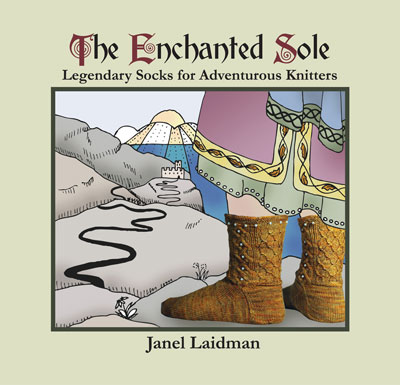
when my wonderful friend janel wrote to ask if my readers would be interested in an installment of her blogger book tour, i jumped at the chance—i know you are a curious, eclectic group and there are areas of knitting we don’t talk about much here (or haven’t yet). i feel a special kinship with janel—she is warm, funny, intelligent, above all, original. we have very different knitting interests and yet we experience a joyful symbiosis when we get together, both personal and professional. what better way to celebrate the release of her second sock book, the enchanted sole, than to talk with her “in person” about her knitting vocation?
janel, i am so thrilled to be talking with you today about your second book, the enchanted sole, available as a collected work and as single pattern downloads as well. not only is this the second book you’ve written; you have also acted as your own publisher for both releases.
i admire your courage!
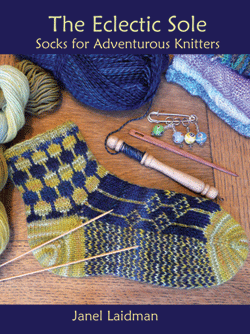
your previous book, the eclectic sole, included a variety of sock patterns chosen from the ones you offered as club picks in the past. it was an appealing collection of sock types that highlighted hand-dyed yarns, such as those you offered through chameleon colorworks, a dye company you previously owned.
how does this new collection differ from that one?
This collection is much more thematic. All of the patterns are based in some way on a myth, legend, or fairy tale or on a general concept from these types of tales. The methods of construction and types of socks still vary, but there is a thematic component that ties them all together.

(atlantis)
how did you decide that a collection based on mythological characters would make a good knitting book, and specifically, a good sock book?
Well, I’ve always liked reading fairy tales! And having an inspiration for a design helps me focus and come up with ideas. I think there are a lot of people like me out there who enjoy reading these types of stories. However, I worked to make each sock very wearable so that even if you aren’t inspired by the myths and legends, you might still be enchanted by the socks. Also, people who might not be adventurous in their choice of sweater are often much more adventurous about their socks. Socks are garments that can be shown off in all their glory, or tucked away under trousers allowing only the wearer to truly appreciate their delights.
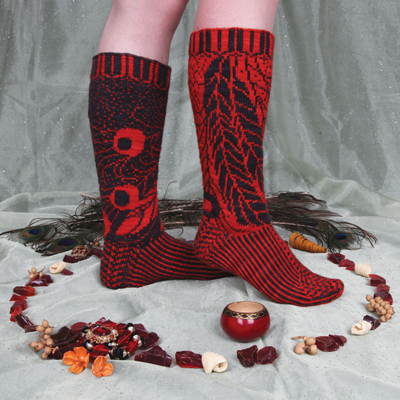
(firebird)
if you could be one of the characters represented in your book, which one would it be and why?
Well, I think it would have to be Naiad. Naiads are water spirits that inhabit springs and fresh water. I have always loved the water, and I used to be a competitive swimmer back in high school. Other people have dreams of flying, but I have dreams of swimming so I think the Naiad must be my kindred spirit.
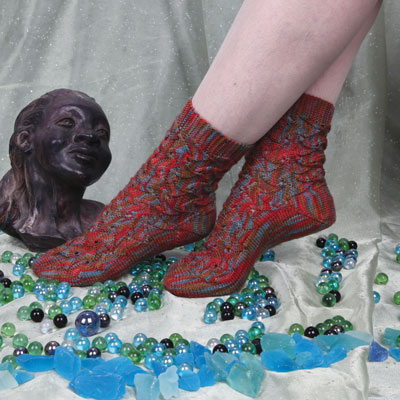
(naiad)
which one do you feel you are actually most like in real life (and why!)?
I think that would have to be the Traveler sock. The traveler represents all the different types of travelers who set out on the road in these kinds of stories. They meet with adventures along the way and are tested by all kinds of situations, both real and magical. The way the traveler responds to the situation determines whether they meet a good fate or a bad end. I think of my life as a journey and an adventure, and I hope the way I respond to the challenges along the way will ensure I meet a good fate!
oooh, the one with the little pocket; i love that you can hide a little something from home as you walk away in that sock . . .
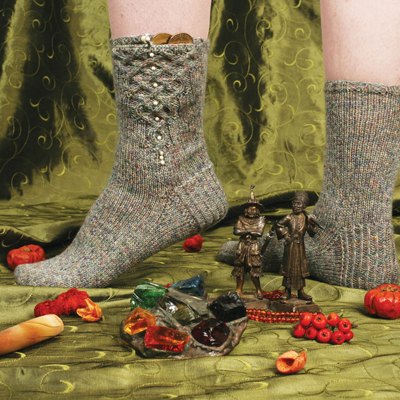
(traveler)
i love this book’s photographic compositions, in which the socks are posed within still-life settings; they call to mind a style of old dutch and northern european painting that i find intriguing. tell us how you came to use this style for the photographs and what sorts of object references you included in them. are there any that are especially important to you?
Thank you. I also love that style of painting. It’s actually quite challenging photographing socks because frequently you don’t include the rest of the person. So all the warmth and personality and charm of a human being has to come through the posing of the foot and its surroundings. I wanted the reader to get a sense of another world when they look at the socks, yet still have it grounded in reality—I mean real people still have to want to wear the socks! My photographer, Ben Wheeler, did an excellent job helping me create just that kind of setting I think. The photo that means the most to me is the Naiad photo, and that’s because the small bust of a woman that looks as if she’s emerging from the water was sculpted by my Dad.
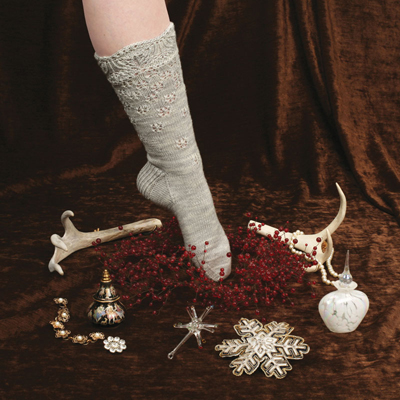
(snow queen)
i’m way too practical about knitting socks, i’m afraid; your designs are much more whimsical! what makes you so fearless about that?
Well, I guess because it’s only a sock! I used to have a very corporate type of job long ago where I had to dress a particular way. And I used to love wearing quirky commercial socks under my suit trousers, it was my way of comforting myself that this grey trouser-y woman wasn’t the real me. The real me enjoyed flowers and ladybugs and asparagus on their socks and dreamed of swimming in the deep blue sea and walking through the cool dark forest. Later, I learned to knit socks and always enjoyed adding a little twist, something to remind myself that I am a little bit quirky. I also find that socks are the perfect sized project to try out design concepts that might be more daunting at a sweater size scale. It’s not too much money to risk in the yarn, and it’s not too much time to risk if they don’t turn out the way you wanted.
what sorts of qualities do you look for in the yarns you use for socks? do your yarn choices vary for different styles of knitting, and if so, why?
I really go for color first and foremost. Color talks to me in a way that inspires. I like both soft yarns and tight twist yarns, and I am not hard on my socks. I wear them fairly gently and I hand wash.
and i must add here that many of the socks featured in janel’s book are knit with yarns by dyers who are also some of my own (and your) favorites, like dye dreams, shalimar, and woolen rabbit.

(mirror mirror)
some of the most striking designs in your book involve two-stranded colorwork, which we don’t talk about much on my blog. tell us what you enjoy about colorwork and why we might consider exploring it more . . .
I absolutely love stranded colorwork because you can’t put it down! You want to keep knitting and knitting and knitting so that you can see the pattern emerge, and how the colors interact.
sounds like the reason we love lace, too . . .
I knit colorwork with one strand of yarn in each hand, so I am knitting both continental style and English style at the same time. It allows me to practice and get both my hands involved. Colorwork can be very complex or fairly straightforward and still have the same satisfying experience, and your choice of yarns and colors can change the look dramatically. If you haven’t done much colorwork, a sock is a nice place to start because it’s a small project. I like to knit my colorwork socks inside out so I don’t have to worry about tension in the project.
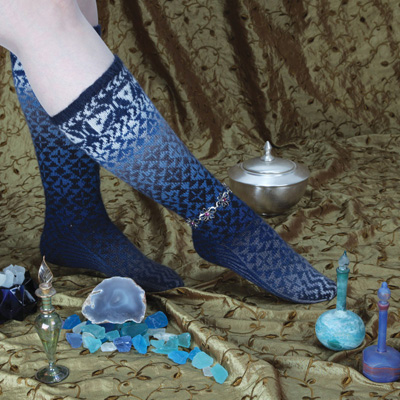
(alchemist)
knitspot readers are very interested in design process; can you tell us a little bit about how you work (i.e., are your designs inspired by narrative and illustration, or by stitches and yarn, by nature and color, or something else, such as architecture or mathematics?)
hmmmm… all of the above. I find there are so many things that inspire me that it’s really good to have a theme to focus me. A lot of my designs are inspired by the yarn. For example the Tintagel socks
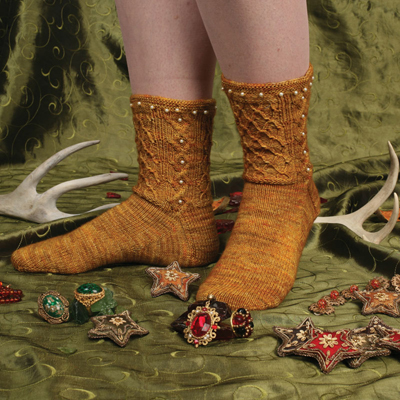
are a beautiful golden yarn from The Woolen Rabbit (Harmony Sock). That yarn just looked regal and rich and I knew it had to be knit up into socks fit for a queen—I added a few pearls and cables and the Tintagel socks were born.
Sometimes I have a technique I want to try, like the Talking Fish socks which are knit sideways with a lace stitch.
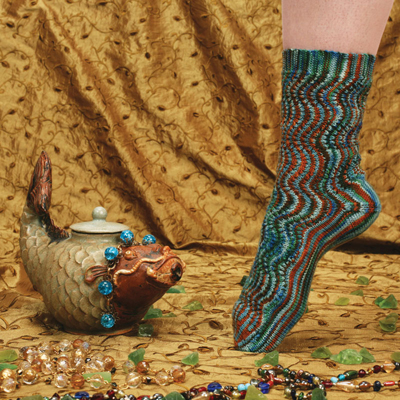
In that case I knew I wanted to work sideways and I wanted to try a lace stitch so I had to find a stitch pattern that I thought would look good in the opposite orientation from how we usually see it. So I searched my stitch dictionaries looking at everything sideways and finally decided on Feather and Fan as the stitch pattern and it looks wonderful undulating vertically instead of horizontally as we usually see it. And then sometimes I have a particular story I want to convey and I have to decide which yarns and which style of sock will best fit that story. The Tree of Life and Labyrinth socks were designed that way. I thought about cables and lace but eventually decided a colorwork sock was the way to go with those designs.

personally, i’m also curious about how you designed this work as a collection; what “rules” did you set up to guide the group of patterns in this book and why is that important?
There weren’t too many rules. The first was that every sock had to relate to myths and legends and fairy tales in some way, although it could be an obscure reference like Tinker or Traveler or Talking Fish. The second rule was that I didn’t want every sock to have the same construction, I wanted to mix it up for variety, some top down, some toe up, some sideways. Finally, I wanted all of the socks to be wearable, nothing so over the top that you would feel a little foolish wearing it. The most unusual sock is the Galadriel sock
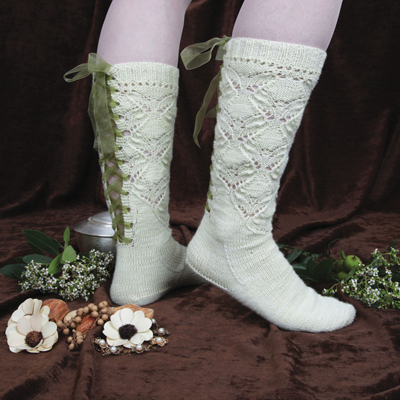
which laces up the back with a ribbon. Although you might not wear it every day, I think it is definitely still wearable, and would look fantastic on the right occasion.
do you prefer to work through ideas as collections or do you sometimes desire to work more linearly?
I definitely like to work through ideas as collections. When I work with a collection, I am working them as variations on a theme, which allows me to really explore that theme to my satisfaction. Before I was a knit designer I was a scientist, and before I was a scientist I was an artist. Both science and art like to look at things from many different angles, trying to assess the true “essence” of the subject. I think I just got used to working that way.
what sorts of fiber interests have you not written about yet?
Oh! I have so many! My next two books are going to be on topics that are definitely not socks—I have lots of book ideas rattling around inside my head and I just have to decide and focus to determine what happens next. I am currently smitten by mittens and think that one of my next books will be about hand coverings. But I am also in love with lace knitting, and textures, and garment construction, so I think there are lots more interests yet to come.
yes, i know you love lace—me too, hahaha! in fact i want to point out your mermaid sock to my readers which has a stitch pattern—oriel lace—found in one of the barbara walker books (as well as in other sources). i thought it was interesting that in your sock, you used the motif to convey the glistening, scaled surface of a mermaid’s skin.

when i designed the irtfa’a shawl, i used the same motif to convey the texture and pattern of the large feathers that cloak the raven’s shoulder area. designers share a common language, or toolset, of stitchery that we use to express our various interpretations of a wide range of real-world surfaces and characteristics. we both used the stitch as a “skin” surface, we both knit the stitch in the “upside down” direction and even used a similar colorway for our separate (and differently-interpreted) projects. a really cool example of how we think alike in different ways . . .
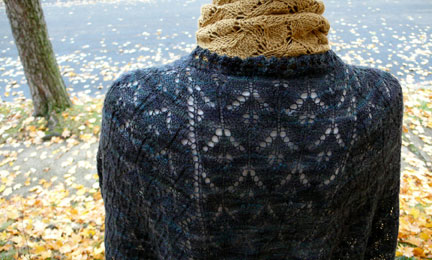
you have an eclectic professional background janel; how do your various experiences contribute to your work as a designer?
Yes, I have worn a lot of hats in my day. I think all experiences in a person’s life lead up to where they are at any given moment. My experience as an art student/artist helped me develop a critical eye for aesthetics, my experience as a scientist helped me develop a desire to experiment. My experiences living in cold, snowy Denmark in the winter helped me develop an appreciation for socks!
i’m often nudged by readers to write a book myself; tell us a bit about what’s involved . . . and what do you enjoy/dislike about tackling a book project?
Writing a book takes first and foremost self discipline to sit down and get it done. Lots of people have good ideas, but if you don’t sit down and put it on paper (or computer) then it only really lives inside your head. However, there is the old saying “How do you eat an elephant?—One bite at a time” and that is also how you write a book. Some days when you’re really stumped, you just work on that page that lists the copyright information, or the resources at the back of the book. But you keep eating bites, even if they’re small.
I enjoy every aspect of the book project, except perhaps when I’m waiting for the final product to arrive—that waiting is excruciating. I also like that book writing goes through definite stages in the process, so just when I get sick of writing patterns, or tech editing, or photography or whatever, it becomes time to move on to a different task. This time around I hired people to help me, like tech editors and photographers and models and that helped a lot.
thank you so much for joining us today; is there anything we haven’t discussed that you’d like to talk about?
Well, thanks for having me! I guess I’d just like to encourage knitters to experiment and not be afraid to try something they haven’t done before. Remember, it’s only knitting, and it’s pretty hard to ruin yarn, you can always frog and make something else if it doesn’t work out—and you will have learned along the way!
once again, we have been speaking with janel laidman, author of the enchanted sole; you can purchase janel’s books and patterns by visiting her site
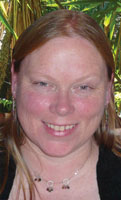
Janel Laidman knits, spins, dreams and writes in Eugene, Oregon, where she is always hard at work on her next endeavor. Janel has taught knitting and spinning nationally and is the author of The Eclectic Sole; Socks for Adventurous Knitters, and her new book The Enchanted Sole; Legendary Socks for Adventurous Knitters.

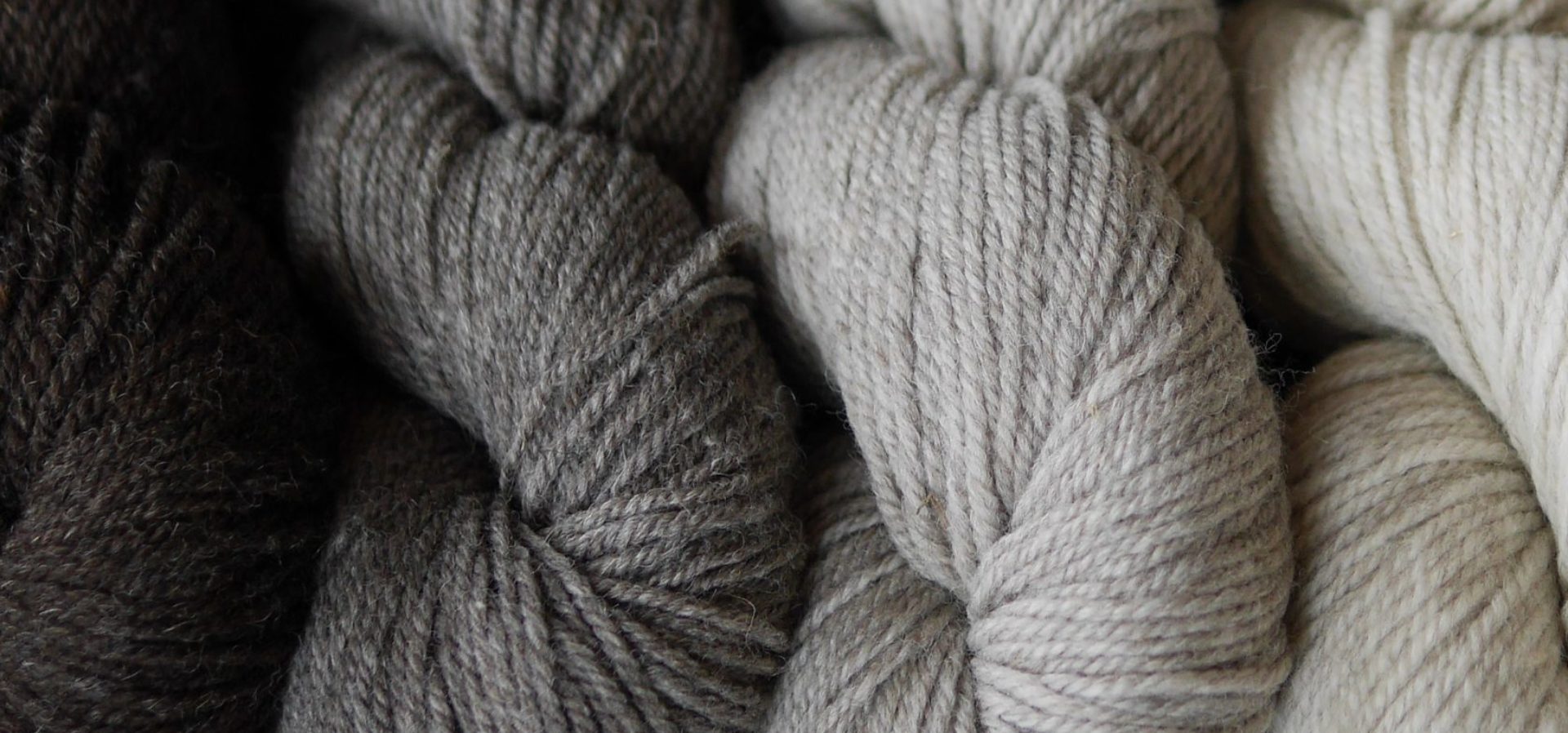
28 thoughts on “the enchanted sole of janel laidman”
What a lovely interview! I can’t wait till my copy comes in. And yes, Anne, I’m waiting for yours too!
This is awesome!!! Thanks Anne!
belegaj trikotajxojn!
Ooh, what a fabulous post!! My copy’s been ordered for ages, and I’m waiting with bated breath for it to arrive. This has just whetted my appetite more 🙂
What a great interview. I really enjoyed reading about Janel’s inspiration and thought process behind the patterns. Oddly enough, I just picked up a copy of The Eclectic Sole from the library (and like many books I check out, I realize I must buy my own copy!) so the timing is even more perfect.
Oh…my…gosh…
My brain is having trouble accepting such fabulous works of art (the socks, I mean). Wow!!! I’ve never done color work because it scares me to death. These socks are something else!!
Thank you for conducting this interview. It made for inspirational reading!
Thank you for this “interview!” The Eclectic Sole AND The Enchanted Sole are both on my Amazon wish list. Now if only I could come up with a book fairy who will leave books on my porch at night while I sleep!
I love it, Janel, that you wore fantabulous socks under your grey suit trousers….I did, too! A close friend at work once said I was the only one she knew who’d wear those socks….and then she saw socks I was knitting and her mind whirred in all sorts of socky directions!
Great interview Anne. I hadn’t realized that she already had a sock book out. Congrats to Janel on her second book! She certainly has captured great color and texture in her patterns.
wow wow wow. although i do not knit socks, i am in awe of these enchanting designs. i must own the book, as if it were a catalog from an exhibition. thank you so much anne. magical.
Lovely interview Anne! Thanks so much to you and Janel for doing it. I am thrilled to get a sneak peek at the gorgeous photos. And I’m so happy to know I wasn’t the only corporate worker fighting the blahs with wild socks.
Thank you for the great interview. I had not heard that Janel had another book out. I need to get it! What beautiful designs, and what inspirational photos.
How nice to have one designer feature another’s work. And lovely work it is….
Those socks are breathtaking!!! Simply incredible!
Thank you Anne for this wonderful interview! I’m adding Janel’s book to my list and adding stranded colorwork socks to my knit-to-do’s!
Congratulations, Janel, on producing your own book!
How nice to see so many lovely socks, and read such a fun interview. I had the pleasure of meeting Janel and some of the socks at Sock Summit!
I am very much looking forward to the book.
Thanks for this great peek into Janel’s work!
Michele
Your interview is great & so interesting. Thank you so much for shring. I have Janel’s 1st book & I do need to have this book too.
I am not a sock knitter. I was never bitten by the bug but looking at the designs in this book makes me wish, for the first time, that I want to knit socks. These are like wearable art and I love the ideas behind them. Really enjoyed reading the interview.
WOW….just wow! The tree if life sock especially…gorgeous!
I love how we fiber sisters support each other in so many ways…..it’s that sisters of the hive thing for me that I love so deeply.
I completely enjoyed your interview with Janel…she is incredibly talented as are you! I am so very humbled and touched that Janel used my yarn for her cover sock.
Very, very cool. You’ve been blogged… I just linked to this article from my ColorJoy blog, hope you get a few new visitors that way.
LynnH
Wow, those are works of art! I wish I felt like I could get colorwork socks to fit me as those are beautiful! I may have to buy this one just to admire the photographs! They would make a lovely calendar.
What a lovely post! I really like the interview format. And it’s especially exciting for me, because later this month at SOAR I will be taking Janel’s short retreat class on spinning yarn for socks! Maybe to do one of her marvelous designs?
That was a great interview–thanks Anne! I’d like to know how Janel knits her sock inside out so she doesn’t need to worry about tension. I think it means she knits on the back dpns with the right side facing in, but it would be facing her. I didn’t know that would help w/tension. Perhaps she’d be willing to share more on that technique sometime.
I will definitely be buying that book. The sock patterns are just gorgeous. Great post.
Loved this interview, it was such a treat to see it on your blog. I’m planning to try some stranded socks later this winter but will never give up my first love: lace!
In answer to Jody’s comment: knitting colorwork “inside out” does help with the stranding because you are carrying the floats around the outside of the sock so they’re a bit longer than if you carry them on the inside as you knit. I found myself knitting this way once and it worked for me!
Oh my, I shouldn’t have shown Janel’s sock photos to my husband. Guess what he wants for Christmas?!
Size 11.5 EEE. Might be Christmas of ’11…
What a great interview!
Comments are closed.